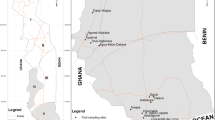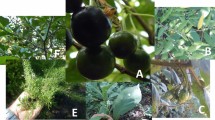Abstract
In this paper we record the native parasitoids associated withAnastrepha fruit flies collected in a native tropical community from Los Tuxtlas, Veracruz, Mexico. A total of 1600 puparia ofAnastrepha were recovered from infested fruits of ten different host plants. From these puparia we obtained 218 Hymenopteran parasitoids representing the following species:Doryctobracon areolatus (Szépligeti),Utetes (Bracanastrepha) aff.anastrephae (Viereck),Doryctobracon crawfordi (Viereck),Opius hirtus (Fischer),Microcrasis n. sp.,Nealiolus n. sp. (all Braconidae);Odontosema n. sp. andLopheucoila sp. (Cynipidae). The most abundant and frequently encountered parasitoid species observed during this study wasD. areolatus, representing 59.2% of all recovered parasitoids. The analysis of different infestation rates in fruits regarding to degree of parasitization in theseAnastrepha species suggest they are not correlated, meanwhile some host plant characteristics such as fruit size, could play an important role in influencing rates of parasitization.
Résumé
Le complexe parasitaire du genreAnastrepha a été étudié dans une localité du Mexique, à Los Tuxtlas, Veracruz. Sur dix espèces différentes de fruits, nous avons obtenu un total de 1 600 nymphes à partir de 10 espèces d'Anastrepha. Ces nymphes ont donné 218 parasitoïdes appartenant aux espèces suivantes:Doryctobracon areolatus (Szépligeti),Utetes (Bracanastrepha) aff.anastrephae (Viereck),Doryctobracon crawfordi (Viereck),Opius hirtus (Fischer),Microcrasis n. sp.,Nealiolus n. sp. (Hymenoptera, Braconidae);Odontosema n. sp. etLopheucoila sp. (Hymenoptera, Cynipidae). L'espèce la plus fréquente et la plus abondante étaitD. areolatus, représentant 59,2% de tous les parasites obtenus. L'analyse des différents taux d'infestation des fruits et des degrés de parasitisme chez ces espèces du genreAnastrepha suggère qu'il n'existe pas de corrélation entre ces 2 données. Cependant, quelques caractéristiques de la plante hôte telle que la taille des fruits, pourraient jouer un rôle important dans le taux de parasitisme.
Similar content being viewed by others
References
Aguiar, E. L., Leonel, F. L., Menezes, E. B. & Zucchi, R. A. — 1992. Natural enemies of fruit flyAnastrepha spp. on different host in the Itaguai county, State of Rio de Janeiro, Brazil. In: First meeting of the Working Group on Fruit Flies of the Western Hemisphere (Abstracts). San José, Costa Rica.
Aluja, M., Guillen J., Liedo, P., Cabrera, M., Ríos E., De la Rosa, G., Celedonio, H. &Mota, D. — 1990. Fruit infesting tephritids: [Dipt.: Tephritidae] and associated parasitoids in Chiapas, Mexico. —Entomophaga, 35, 39–48.
Baker, A. C., Stone, W. E., Plummer, C. C. &Mcphail, M. — 1944. A review of studies on the Mexican fruitfly and related Mexican species. —U.S. Dept. Agr. Misc. Publ., 531, 1–155.
Carabias-Lillo & Guevara, S. — 1985. Fenología de una selva tropical húmeda y en una comunidad derivada: Los Tuxtlas, Veracruz. — In: Investigaciones sobre la regeneración de selvas altas en Veracruz, México II (Gómez Pompa, A. & Del Amo, S., Eds.). —Alhambra Mexicana, 27–66.
Costa Lima, A. Da. — 1937. Vespas do generoOpius, parasitas de larvas de moscas de frutas [Hymenoptera: Braconidae]. —O. Campo, 8, 22–31.
Estrada, A., Coates-Estrada, R. & Martinez-Ramos, M. — 1985. La Estación de Biología Tropical Los Tuxtlas: un recurso para el estudio y conservación de las selvas del trópico húmedo. In: Investigaciones sobre la regeneración de selvas altas en Veracruz, México II (Gómez Pompa, A. & Del Amo, S., Eds.). —Alhambra Mexicana, 379–393.
Fernandez, de A. D. &Nasca J. A. — 1984. Especies de Braconidae: [Hymenoptera: Ichneumonoidea] parasitoides de moscas de los frutos [Diptera: Tephritidae] colectados en la provincia de Tucumán (Argentina). —CIRPON Rev. Invest. 2, 37–46.
García, E. — 1973. Modificaciones al sistema de clasificación climática de Köpen (para adaptarlo a las condiciones de la República Mexicana). —Instituto de Geografía, U.N A.M., 246 pp.
González-Hernández &Tejada, L. O. — 1979. Fluctuación de la población deAnastrepha ludens (Loew) y de sus enemigos naturales enSargentia gregii Watts. —Folia Entomol. Mex., 41, 49–60.
Hernandez-Ortiz, V. &Pérez-Alonso, R. — 1993. The natural host plants ofAnastrepha [Diptera: Tephritidae] in a tropical rain forest of Mexico. —Fla Entomol., 76, 447–460.
Howarth, F. — 1991. Environmental impacts of classical biological control. —Ann. Rev. Entomol., 36, 485–509.
Ibarra, M. G. &Sinaca, S. — 1987. Listados florísticos de México VII. Estación de Biología Tropical Los Tuxtlas, Veracruz. —Inst. Biología, U.N.A.M., México, 51 pp.
Jiménez-Jiménez, E. — 1956. Las moscas de la fruta y sus enemigos naturales. —Fitófilo, 15, 4–11.
Jiménez-Jiménez, E. — 1958. Empleo de enemigos naturales para el control de insectos que constituyen plagas agrícolas en la República Mexicana. —Fitófilo, 21, 5–30.
Jimenez-Jiménez, E. — 1967.Pachycrepoideus vindemmiae (Rond.) [Hymenoptera, Pteromalidae], enemigo natural de las moscas de la fruta. —Fitófilo, 56, 31.
Jirón, L. F. &Mexzon, R. G. — 1989. Parasitoid Hymenopterans of Costa Rica: geographical distribution of the species associated with fruit flies [Diptera: Tephritidae]. —Entomophaga, 34, 53–60.
Lot-Helgueras, A. — 1976. La Estación de Biología Tropical Los Tuxtlas: pasado, presente y futuro. In: Investigaciones sobre la regeneración de selvas altas en Veracruz, México (Gómez Pompa, A. et al. Eds.). —C.E.C.S.A., México, 31–69.
Marsh, P. M. — 1979. FamilyBraconidae. In: Catalog ofHymenoptera in America north of Mexico (Krombein, K. V., Hurd, P. D., Smith, D. R. & Burks, B. D., Eds.) —Smithsonian Inst. Press., 1, 144–313.
Norrbom, A. L. & Kim, K. C. — 1988. A list of the reported host plants of the species ofAnastrepha [Diptera: Tephritidae]. — U.S. Dept. Agr. APHIS-PPOQ, 81-52, 114 pp.
Plummer, C. C. &McPhail, M. — 1941. The yellow chapote, a native host of the Mexican fruitfly. —U.S. Dept. Agr. Tech. Bull. 775, 1–12.
Rzedowski, J. — 1988. Vegetación de México. —LIMUSA, México (cuarta reimpresión), 432 pp.
Sivinski, J. — 1991. The influence of host fruit morphology on parasitization rates in the Caribbean fruit fly,Anastrepha suspensa. —Entomophaga, 36, 447–454.
Soto-Esparza, M. — 1976. Algunos aspectos climáticos de la región de Los Tuxtlas, Veracruz. In: Investigaciones sobre la regeneración de selvas altas en Veracruz, México (Gómez Pompa, A. et al. Eds.). —C.E.C.S.A., Mexico, 70–111.
Wharton, R. A. — 1984. Biology of theAlysiini [Hymenoptera: Braconidae], parasitoids of cyclorrhaphousDiptera. —Texas Agr. Exp. Stn. Tech. Monogr., 11, 1–39.
Wharton, R. A. — 1987. Changes in nomenclature and classification of someOpiinae Braconidae [Hymenoptera]. —Proc. Entomol. Soc. Wash., 89, 61–73.
Wharton, R. A. &Gilstrap, F. E. — 1983. Key to and status ofOpiinae Braconid [Hymenoptera] parasitoids used in biological control ofCeratitis andDacus s.1. [Diptera: Tephritidae]. —Ann. Entomol. Soc. Am., 76, 721–742.
Wharton, R. A., Gilstrap, F. E., Rhode, R. H., Fischer, M. &Hart, W. G. —1981. Hymenopterous egg-pupal and larval-pupal parasitoids ofCeratitis capitata andAnastrepha spp. [Dipt.: Tephritidae] in Costa Rica. —Entomophaga, 26, 285–290.
Wharton, R. A. &Marsh, P. M. — 1978. New WorldOpiinae [Hymenoptera: Braconidae] parasitic onTephritidae [Diptera]. —J. Wash. Acad. Sci., 68, 147–167.
Yépes, F. R. &Vélez, A. — 1989. Contribución al conocimiento de las moscas de las frutas (Tephritidae) y sus parasitoides en el Departamento de Antioquia. —Rev. Fac. Nal. Agr. Medellín, 42, 73–98.
Author information
Authors and Affiliations
Rights and permissions
About this article
Cite this article
Hernández-Ortiz, V., Pérez-Alonso, R. & Wharton, R.A. Native parasitoids associated with the genusAnastrepha (Dipt.: Tephritidae) in Los Tuxtlas, Veracruz, Mexico. Entomophaga 39, 171–178 (1994). https://doi.org/10.1007/BF02372355
Received:
Accepted:
Issue Date:
DOI: https://doi.org/10.1007/BF02372355




